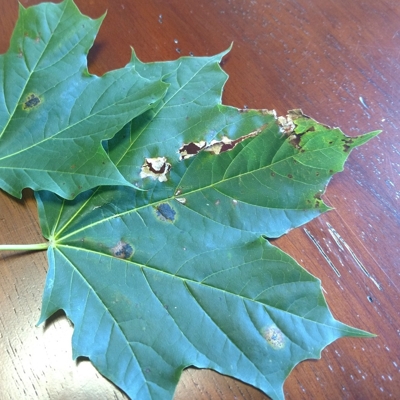Tar Spot of Maple
During late summer and into fall, maples and several other tree species can be seen sporting numerous striking black spots on their leaves. Because the spots are conspicuous, thanks to their dark color against the lighter green or fall color of the leaves, they can cause concern to the owner of the tree. Tar spot of maple is caused by a few different fungi in the genus Rhytisma and the disease is aptly named ‘tar spot’ because that’s exactly what it looks like on the leaves

Image by Susan Pelton, UConn H & G
Life Cycle
Infection takes place in the spring on new leaves. Spores are produced during damp weather within tar spots on fallen leaves from the previous season. These spores are dispersed to new leaves by wind and splashing rain. The first evidence of infection is a small yellow or pale green spot on the leaf. Over the summer the spot expands. In mid to late summer black spots develop on the upper leaf surface. In some species there are many small black spots. If the spots remain small, about 0.004 inches (1mm) across, the common name of the disease is speckled tar spot and the causal fungus is R. punctatum. The most common tar spot on native maples in North America is characterized by prominent raised tar spots about 0.25-0.5 inches (6.35 to 12.7mm) across and the fungus responsible is R. americanum. Giant tar spot, common in the northeastern U.S. on Norway and other European maples, starts out as many small black spots but they later coalesce, forming a single large black spot that can be 1-1.5 inches (2.54 to 3.81cm) in diameter and may have a yellow border. The spots are not as raised and rippled as those caused by R. americanum. Caused by R. acerinum, giant tar spot was first described in Europe by mycologist Christiaan Hendrik Persoon in 1794.
Control
While numerous infections and spots on the leaves look unattractive once the black fungal stromata develop, this disease does not typically cause the host tree any harm. Occasionally tar spots can be numerous enough to result in somewhat earlier than normal leaf drop but, even then, the impact on the tree is still negligible because this typically occurs late in the season. To minimize new infections the following spring, rake up and dispose of infected leaves in the fall. The use of fungicides on newly emerging leaves in the spring is rarely warranted as it can be cost-prohibitive. The entire canopy may need to be treated top and bottom and it may be ineffective if there are any other infected maples nearby.
Despite good cultural practices, pests and diseases at times may appear. Chemical control should be used only after all other methods have failed. For pesticide information or other questions please call toll free: 877-486-6271.
UConn Home and Garden Education Center, Joan Allen 2015, revised 2019.
Issued in furtherance of Cooperative Extension work, Acts of May 8 and June 30, 1914, in cooperation with the U.S. Department of Agriculture, the Dean of the College, Cooperative Extension System, University of Connecticut, Storrs. The Connecticut Cooperative Extension System is an equal opportunity employer and program provider. To file a complaint of discrimination, write USDA, Director, Office of Civil Rights, Room 326-W, Whitten Building, Stop Code 9410, 1400 Independence Avenue, SW, Washington, DC 20250-9410 or call (202) 720-5964.